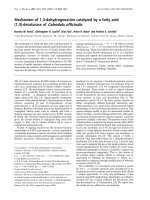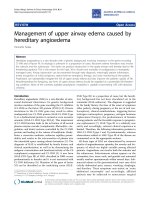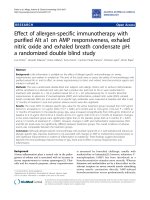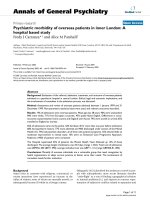Báo cáo y học: " Review of "Systems Biology in Practice" by Edda Klipp, Ralf Hertwig, Axel Kowald, Christoph Wierling and Hans Lehrach" docx
Bạn đang xem bản rút gọn của tài liệu. Xem và tải ngay bản đầy đủ của tài liệu tại đây (168.8 KB, 2 trang )
BioMed Central
Page 1 of 2
(page number not for citation purposes)
Theoretical Biology and Medical
Modelling
Open Access
Book review
Review of "Systems Biology in Practice" by Edda Klipp, Ralf
Hertwig, Axel Kowald, Christoph Wierling and Hans Lehrach
Paul S Agutter*
Address: Theoretical and Cell Biology Consultancy, 26 Castle Hill, Glossop, Derbyshire, UK
Email: Paul S Agutter* -
* Corresponding author
Book details
Klipp E, Herwig R, Kowald A, Wierling C, Lehrach H: Systems
Biology in Practice Berlin: Wiley-VCH; 2005. 449 pages, ISBN-
10 3-527-31078-9, ISBN-13 978-3-527-31078-4. Eur 99.00
hardback
Systems biology – the study of such functional networks
as cellular metabolism, signalling and gene expression – is
a rapid growth area, as illustrated by many recent publica-
tions in Theoretical Biology and Medical Modelling and other
journals. Its emergence has been fostered by the develop-
ment of automated, high-throughput techniques such as
DNA microarrays, of the ever-increasing storage capacity
and calculating speed of computers, of new mathematical
tools, and of modern electronic communications. Its
impact on biological research is already evident: tradi-
tional data (e.g. the results of single-gene studies) are
being reinterpreted in a broader cellular context, radically
new research strategies are appearing, novel insights into
the integration of cell systems are being gained, and the
prospects for advances in medicine, biotechnology, ecol-
ogy and other areas of applied science and technology
seem, to the optimistic, almost limitless. To write a book
surveying the concepts, methods and potential applica-
tions of this nascent though already wide field was a chal-
lenging enterprise, but the authors of Systems Biology in
Practice have largely achieved their objective. This is a
timely volume that should be welcomed both by practis-
ing systems biologists and by newcomers to the field.
The book is divided into three parts. Part I (chapters 1–4),
occupying about a quarter of the main text, introduces the
relevant biological and mathematical concepts and exper-
imental techniques. Part II (chapters 5–12), occupying the
following two-thirds of the book, focuses on the three
main facets of systems biology as it stands today (metab-
olism, signal transduction and gene expression), but it
also includes brief surveys of the cell cycle and ageing, an
interesting chapter on evolution and self-organization, a
discussion of data integration methods, and a brief but
lively speculation about future directions and applica-
tions. The short final part (chapters 13–14) is a descriptive
list of currently-available internet databases and tools and
modelling tools, assessing the advantages and disadvan-
tages of each. Every concept and method introduced
throughout the book is illustrated by at least one boxed
example – a well-attested and effective pedagogical device
– and most of the examples used are clear and appropri-
ate. The overall organization of the text is lucid, the index
is thorough, and the publishers are to be commended on
a very well-produced volume.
Inevitably, since this is a pioneering work on the subject,
there are flaws. Informed readers will notice omissions;
for example, the otherwise excellent account of metabolic
control theory in chapter 5 makes no mention of the bio-
chemical systems theory of Savageau, Voit and their col-
leagues, which some authorities consider conceptually
and methodologically superior in certain applications.
The balance between sections of the text seems odd in
places. In chapter 3, for instance, after clear and well-
directed introductions to linear algebra and ordinary dif-
ferential equations, the authors launch into an account of
advanced statistical theory (section 3.4.1) that has little
direct relevance to the remainder of the book – in contrast
to the remainder of section 3.4, where various statistical
Published: 26 August 2005
Theoretical Biology and Medical Modelling 2005, 2:34 doi:10.1186/1742-4682-2-34
Received: 06 August 2005
Accepted: 26 August 2005
This article is available from: />© 2005 Agutter; licensee BioMed Central Ltd.
This is an Open Access article distributed under the terms of the Creative Commons Attribution License ( />),
which permits unrestricted use, distribution, and reproduction in any medium, provided the original work is properly cited.
Publish with BioMed Central and every
scientist can read your work free of charge
"BioMed Central will be the most significant development for
disseminating the results of biomedical research in our lifetime."
Sir Paul Nurse, Cancer Research UK
Your research papers will be:
available free of charge to the entire biomedical community
peer reviewed and published immediately upon acceptance
cited in PubMed and archived on PubMed Central
yours — you keep the copyright
Submit your manuscript here:
/>BioMedcentral
Theoretical Biology and Medical Modelling 2005, 2:34 />Page 2 of 2
(page number not for citation purposes)
techniques and their practical applications are well
described – and would be better placed in an appendix, if
not omitted. Chapter 5 begins with 20 pages of elemen-
tary thermodynamics and enzymology, surely elementary
for most readers, and ends with the same amount of text
– a mere 20 pages – on metabolic control theory, which is
less likely to be familiar and is far more mathematically
sophisticated. Much of the account of ageing in chapter 7
is devoted to the defective mitochondria theory – reason-
ably, in that one of the authors (Kowald) has been a major
contributor to this theory, but less reasonably in that sev-
eral alternative models of ageing in the literature are
scarcely considered. There are several misprints: for exam-
ple, equation 3.21 (p. 63) is incorrect, 'sites' is written for
'sides' (p. 67) and 'mitochondrium' for 'mitochondrion'
(p. 168). In places, the writing would have benefited from
the assistance of a native English speaker; odd phrasing
such as 'negative definite' for 'always negative' (p. 74,
example 3–10 and surrounding text) is distracting. Per-
haps more importantly for some readers, the authors have
concentrated throughout on ordinary differential equa-
tion models. Stochastic modelling is mentioned where it
is potentially relevant, but only briefly, and this might be
the most serious imbalance in the book; as the authors
admit, the continuum hypothesis is unlikely to be valid in
modelling many aspects of signal processing and tran-
scriptional regulation.
Because of the rate of progress in systems biology, it seems
likely that a second edition of this book will appear before
many years have passed. It is to be hoped that these
(mostly minor) defects will be eliminated in the next edi-
tion. However, they detract little from the value of the
work as it stands. I expect to consult it regularly over the
foreseeable future, and I am confident that biologists eve-
rywhere will benefit from having a copy to hand.









